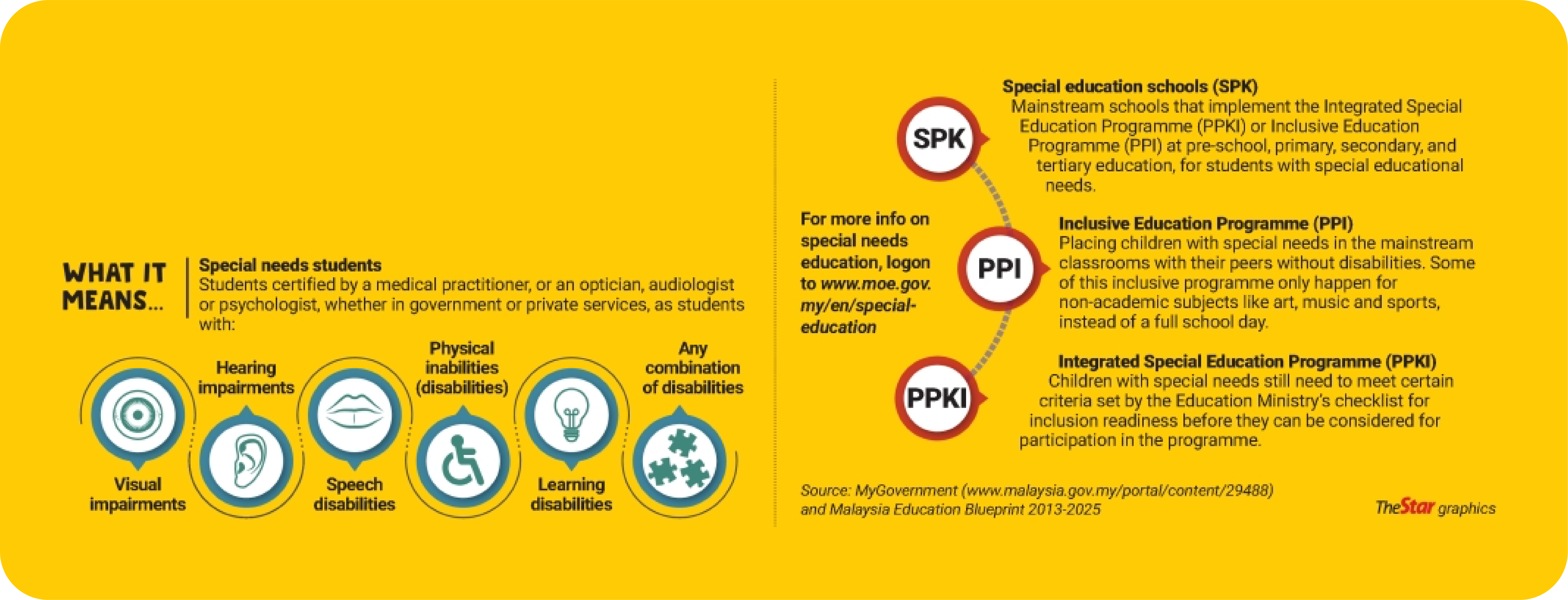Understanding Inclusive Education for Students with Autism
Introduction
Every child, regardless of their abilities, has the right to access the same educational opportunities.
Article 28 of Malaysia’s Persons with Disabilities Act 2008 guarantees the support necessary for children with special education needs (SEN) to fully participate in education. The Ministry of Education’s (MOE) Zero Reject Policy (2018) ensures that every student receives an education suited to their abilities and confirms the right of parents to choose the school (in their neighbourhood) and type of class for their children.
Despite this, navigating the world of special needs education in Malaysia can be both confusing and frustrating for parents of children with autism.
This article aims to assist parents in making well-informed decisions about school choices for their autistic children to better support their learning and development.

What is Special Needs Education?
Instead, it involves adjusting learning goals, materials, and teaching methods, as well as providing special equipment and ensuring the school is accessible.
Definition of special education in Malaysia
– Special Education Regulations 2013 (under the Education Act 1996)
What is Inclusive Education?
Inclusive education welcomes all students to local schools in age-appropriate classes, regardless of their abilities or disabilities, ensuring they learn and participate meaningfully with their peers. In Malaysia, the Education Blueprint 2013-2025 defines inclusive education as special needs education for students with specific impairments and disabilities. Special needs students are those certified by medical professionals and registered as Persons with Disabilities (OKU).
See OKU Registration Pathway for more information on the registration process.

Inclusive education is not just about integrating students with autism into mainstream classrooms. It involves transforming the entire education system to support all students. This means removing barriers to education, such as access, learning, and social participation, by providing individualised support and valuing the diversity each student brings to the school community.
This includes:
- Making teaching methods, language, and curriculum accessible to diverse learners with adaptive tools and flexible goals.
- Ensuring the school environment is accessible.
- Fostering understanding of disability and diversity.
The table below shows the ideal inclusive environment and current practices.
Inclusion of students with SEN: Ideal vs Common Practice in Malaysia
|
Ideal Inclusion |
Common Practice |
|---|---|
|
The student takes part in the regular classroom with personalised support. |
|
|
The student can access the same curriculum with accommodations and modifications. |
|
|
The student is engaged and interacts with classmates. |
|
|
The student is an independent, valued, and respected member of the class. |
|
|
Ideal Inclusion |
Common Practice |
|---|---|
|
The student takes part in the regular classroom with personalised support. |
|
|
The student can access the same curriculum with accommodations and modifications. |
|
|
The student is engaged and interacts with classmates. |
|
|
The student is an independent, valued, and respected member of the class. |
|
Definition of inclusive education in Malaysia
– Special Education Regulations 2013 (under the Education Act 1996)
Benefits of inclusive learning environment
For children and families with autism, inclusive education allows meaningful participation in school and community activities. This early inclusion lays the foundation for future acceptance and involvement in workplaces and broader society.
A comprehensive review by Hehir and colleagues in 2016 showed that inclusive education improves the academic performance and social-emotional growth of all students, whether they have SEN or not. It also encourages teachers to use new teaching methods called Universal Design for Learning (UDL). UDL offers various ways for students to engage with material, understand concepts, and demonstrate their learning, benefiting everyone.
References
- Amar-Singh, HSS. (2020) Education in Malaysia for Children with Special Needs Progress, Critical Gaps, Efforts under Way and Policy. Asia-Pacific Economic Cooperation (APEC) Human Resources Development Working Group (HRDWG). https://doi.org/10.13140/RG.2.2.30019.07204
- Bunch G. & Valeo A. (2004). Student attitudes toward peers with disabilities in inclusive and special education schools, Disability & Society, 19:1, 61-76.
- Hehir T, Grindal T., Freeman B., Lamoreau R., Borquaye Y., Burke S. (2016). A Summary of the Evidence on Inclusive Education. Prepared for the Instituto Alana, São Paulo. https://eric.ed.gov/?id=ED596134
- Simón C., Martínez-Rico G., McWilliam R.A. et al. (2023) Attitudes Toward Inclusion and Benefits Perceived by Families in Schools with Students with Autism Spectrum Disorders. J Autism Dev Disord 53, 2689–2702. https://doi.org/10.1007/s10803-022-05491-5
Resources
- Persons with Disabilities Act 2008 (Section 28: Access to Education, p.23)FAQ: Support for Parents of Children with Special Needs to obtain their Rights in Inclusive Education (National Family Support Group for Children & People with Special Needs)
- Special Education Regulations 2013 (under the Education Act 1996)
- Malaysian Education Blueprint, 2013 – 2025

